Leadership Profile Analysis: Observing Effective Leadership
VerifiedAdded on 2023/06/04
|6
|1377
|82
Report
AI Summary
This report provides an analysis of effective leadership, focusing on the qualities and styles exhibited by a personally observed leader. The introduction defines leadership and its importance in organizations, highlighting the need for leaders who can unite teams and make crucial decisions. The analysis section examines a friend's leadership qualities, including communication, decision-making, leading by example, integrity, and motivation. The report further discusses leadership effectiveness, emphasizing the importance of outcomes and the application of democratic leadership principles. The conclusion summarizes the leader's positive attributes and their impact, emphasizing the value of democratic leadership in fostering team involvement and satisfaction. The report is well-referenced with APA format.

Leadership
Paraphrase This Document
Need a fresh take? Get an instant paraphrase of this document with our AI Paraphraser
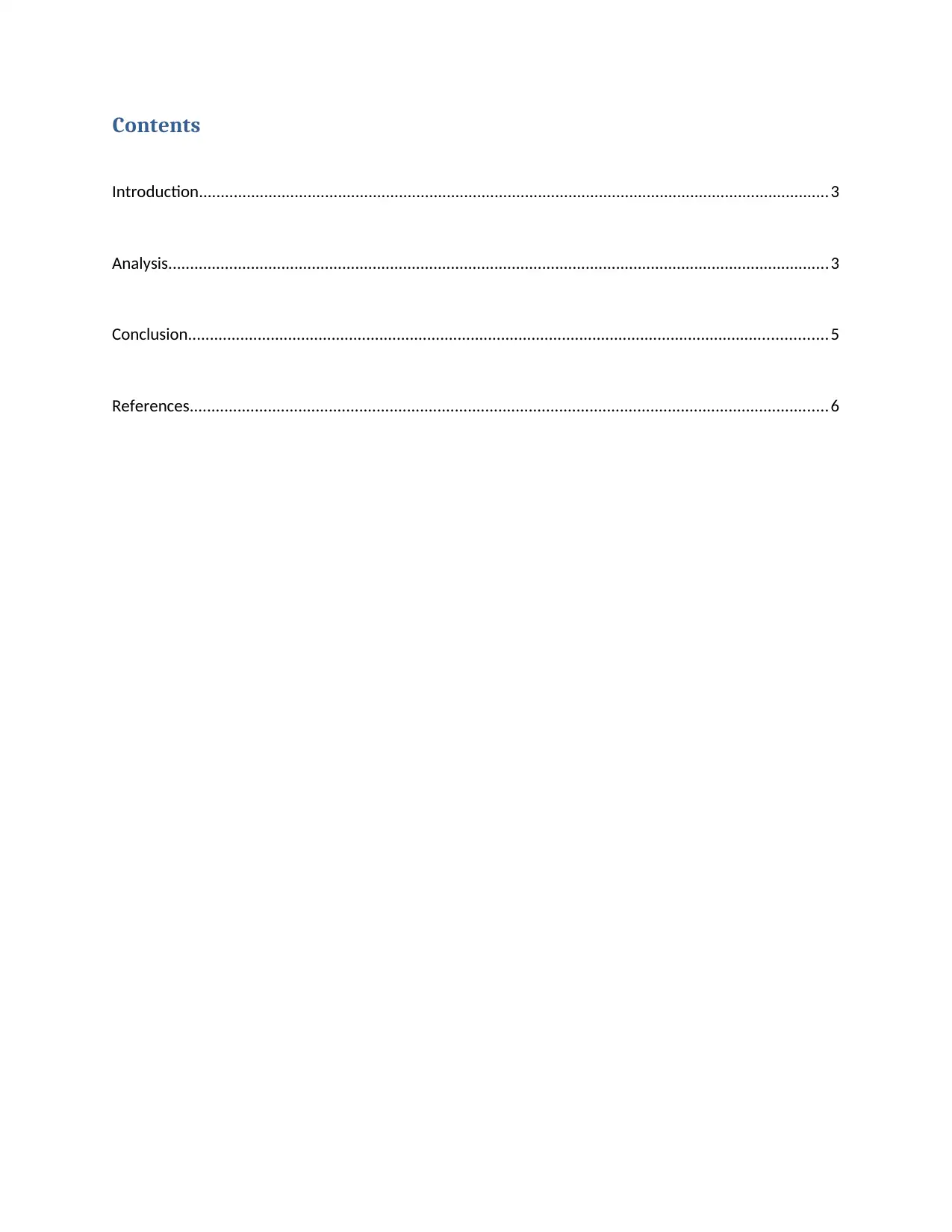
Contents
Introduction.................................................................................................................................................3
Analysis........................................................................................................................................................3
Conclusion...................................................................................................................................................5
References...................................................................................................................................................6
Introduction.................................................................................................................................................3
Analysis........................................................................................................................................................3
Conclusion...................................................................................................................................................5
References...................................................................................................................................................6
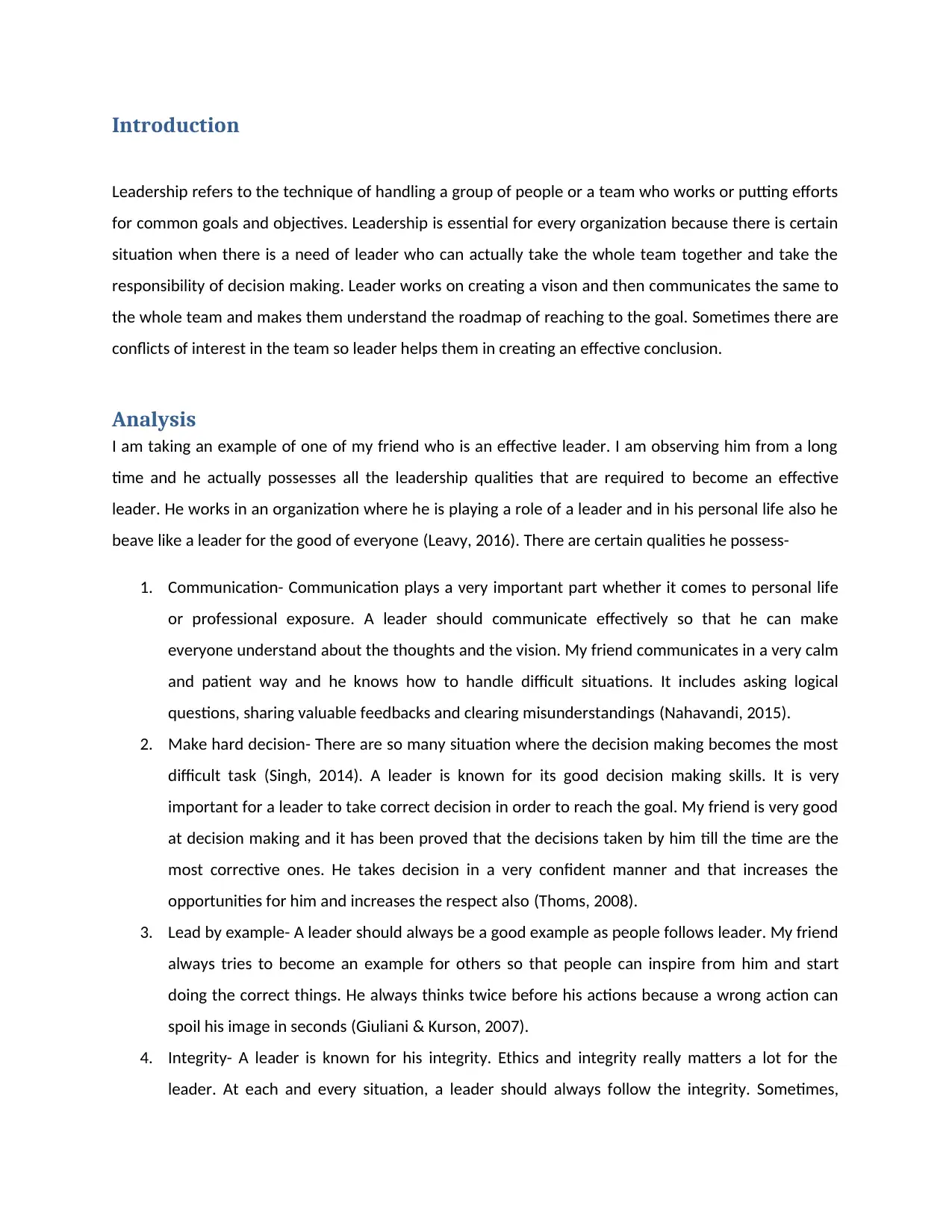
Introduction
Leadership refers to the technique of handling a group of people or a team who works or putting efforts
for common goals and objectives. Leadership is essential for every organization because there is certain
situation when there is a need of leader who can actually take the whole team together and take the
responsibility of decision making. Leader works on creating a vison and then communicates the same to
the whole team and makes them understand the roadmap of reaching to the goal. Sometimes there are
conflicts of interest in the team so leader helps them in creating an effective conclusion.
Analysis
I am taking an example of one of my friend who is an effective leader. I am observing him from a long
time and he actually possesses all the leadership qualities that are required to become an effective
leader. He works in an organization where he is playing a role of a leader and in his personal life also he
beave like a leader for the good of everyone (Leavy, 2016). There are certain qualities he possess-
1. Communication- Communication plays a very important part whether it comes to personal life
or professional exposure. A leader should communicate effectively so that he can make
everyone understand about the thoughts and the vision. My friend communicates in a very calm
and patient way and he knows how to handle difficult situations. It includes asking logical
questions, sharing valuable feedbacks and clearing misunderstandings (Nahavandi, 2015).
2. Make hard decision- There are so many situation where the decision making becomes the most
difficult task (Singh, 2014). A leader is known for its good decision making skills. It is very
important for a leader to take correct decision in order to reach the goal. My friend is very good
at decision making and it has been proved that the decisions taken by him till the time are the
most corrective ones. He takes decision in a very confident manner and that increases the
opportunities for him and increases the respect also (Thoms, 2008).
3. Lead by example- A leader should always be a good example as people follows leader. My friend
always tries to become an example for others so that people can inspire from him and start
doing the correct things. He always thinks twice before his actions because a wrong action can
spoil his image in seconds (Giuliani & Kurson, 2007).
4. Integrity- A leader is known for his integrity. Ethics and integrity really matters a lot for the
leader. At each and every situation, a leader should always follow the integrity. Sometimes,
Leadership refers to the technique of handling a group of people or a team who works or putting efforts
for common goals and objectives. Leadership is essential for every organization because there is certain
situation when there is a need of leader who can actually take the whole team together and take the
responsibility of decision making. Leader works on creating a vison and then communicates the same to
the whole team and makes them understand the roadmap of reaching to the goal. Sometimes there are
conflicts of interest in the team so leader helps them in creating an effective conclusion.
Analysis
I am taking an example of one of my friend who is an effective leader. I am observing him from a long
time and he actually possesses all the leadership qualities that are required to become an effective
leader. He works in an organization where he is playing a role of a leader and in his personal life also he
beave like a leader for the good of everyone (Leavy, 2016). There are certain qualities he possess-
1. Communication- Communication plays a very important part whether it comes to personal life
or professional exposure. A leader should communicate effectively so that he can make
everyone understand about the thoughts and the vision. My friend communicates in a very calm
and patient way and he knows how to handle difficult situations. It includes asking logical
questions, sharing valuable feedbacks and clearing misunderstandings (Nahavandi, 2015).
2. Make hard decision- There are so many situation where the decision making becomes the most
difficult task (Singh, 2014). A leader is known for its good decision making skills. It is very
important for a leader to take correct decision in order to reach the goal. My friend is very good
at decision making and it has been proved that the decisions taken by him till the time are the
most corrective ones. He takes decision in a very confident manner and that increases the
opportunities for him and increases the respect also (Thoms, 2008).
3. Lead by example- A leader should always be a good example as people follows leader. My friend
always tries to become an example for others so that people can inspire from him and start
doing the correct things. He always thinks twice before his actions because a wrong action can
spoil his image in seconds (Giuliani & Kurson, 2007).
4. Integrity- A leader is known for his integrity. Ethics and integrity really matters a lot for the
leader. At each and every situation, a leader should always follow the integrity. Sometimes,
⊘ This is a preview!⊘
Do you want full access?
Subscribe today to unlock all pages.

Trusted by 1+ million students worldwide
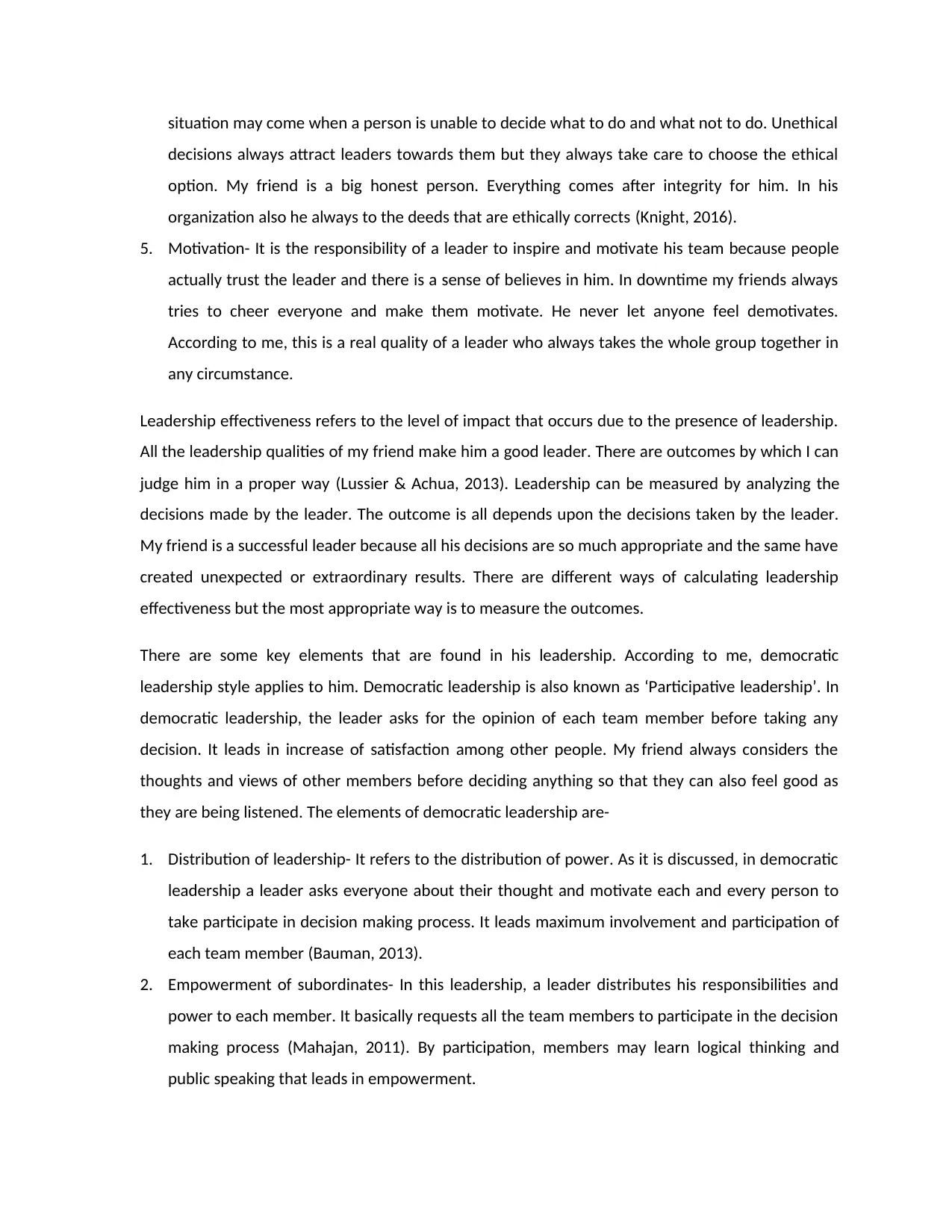
situation may come when a person is unable to decide what to do and what not to do. Unethical
decisions always attract leaders towards them but they always take care to choose the ethical
option. My friend is a big honest person. Everything comes after integrity for him. In his
organization also he always to the deeds that are ethically corrects (Knight, 2016).
5. Motivation- It is the responsibility of a leader to inspire and motivate his team because people
actually trust the leader and there is a sense of believes in him. In downtime my friends always
tries to cheer everyone and make them motivate. He never let anyone feel demotivates.
According to me, this is a real quality of a leader who always takes the whole group together in
any circumstance.
Leadership effectiveness refers to the level of impact that occurs due to the presence of leadership.
All the leadership qualities of my friend make him a good leader. There are outcomes by which I can
judge him in a proper way (Lussier & Achua, 2013). Leadership can be measured by analyzing the
decisions made by the leader. The outcome is all depends upon the decisions taken by the leader.
My friend is a successful leader because all his decisions are so much appropriate and the same have
created unexpected or extraordinary results. There are different ways of calculating leadership
effectiveness but the most appropriate way is to measure the outcomes.
There are some key elements that are found in his leadership. According to me, democratic
leadership style applies to him. Democratic leadership is also known as ‘Participative leadership’. In
democratic leadership, the leader asks for the opinion of each team member before taking any
decision. It leads in increase of satisfaction among other people. My friend always considers the
thoughts and views of other members before deciding anything so that they can also feel good as
they are being listened. The elements of democratic leadership are-
1. Distribution of leadership- It refers to the distribution of power. As it is discussed, in democratic
leadership a leader asks everyone about their thought and motivate each and every person to
take participate in decision making process. It leads maximum involvement and participation of
each team member (Bauman, 2013).
2. Empowerment of subordinates- In this leadership, a leader distributes his responsibilities and
power to each member. It basically requests all the team members to participate in the decision
making process (Mahajan, 2011). By participation, members may learn logical thinking and
public speaking that leads in empowerment.
decisions always attract leaders towards them but they always take care to choose the ethical
option. My friend is a big honest person. Everything comes after integrity for him. In his
organization also he always to the deeds that are ethically corrects (Knight, 2016).
5. Motivation- It is the responsibility of a leader to inspire and motivate his team because people
actually trust the leader and there is a sense of believes in him. In downtime my friends always
tries to cheer everyone and make them motivate. He never let anyone feel demotivates.
According to me, this is a real quality of a leader who always takes the whole group together in
any circumstance.
Leadership effectiveness refers to the level of impact that occurs due to the presence of leadership.
All the leadership qualities of my friend make him a good leader. There are outcomes by which I can
judge him in a proper way (Lussier & Achua, 2013). Leadership can be measured by analyzing the
decisions made by the leader. The outcome is all depends upon the decisions taken by the leader.
My friend is a successful leader because all his decisions are so much appropriate and the same have
created unexpected or extraordinary results. There are different ways of calculating leadership
effectiveness but the most appropriate way is to measure the outcomes.
There are some key elements that are found in his leadership. According to me, democratic
leadership style applies to him. Democratic leadership is also known as ‘Participative leadership’. In
democratic leadership, the leader asks for the opinion of each team member before taking any
decision. It leads in increase of satisfaction among other people. My friend always considers the
thoughts and views of other members before deciding anything so that they can also feel good as
they are being listened. The elements of democratic leadership are-
1. Distribution of leadership- It refers to the distribution of power. As it is discussed, in democratic
leadership a leader asks everyone about their thought and motivate each and every person to
take participate in decision making process. It leads maximum involvement and participation of
each team member (Bauman, 2013).
2. Empowerment of subordinates- In this leadership, a leader distributes his responsibilities and
power to each member. It basically requests all the team members to participate in the decision
making process (Mahajan, 2011). By participation, members may learn logical thinking and
public speaking that leads in empowerment.
Paraphrase This Document
Need a fresh take? Get an instant paraphrase of this document with our AI Paraphraser
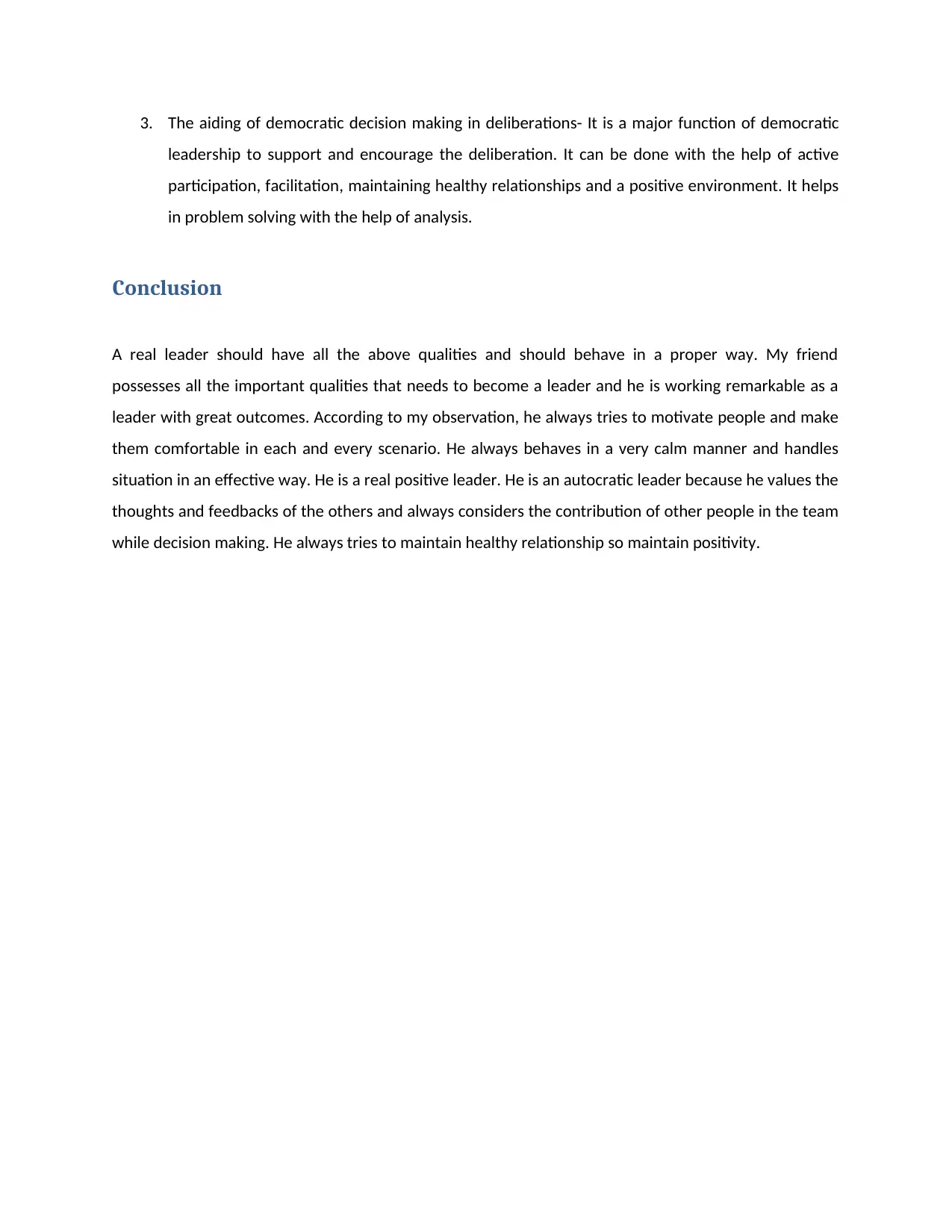
3. The aiding of democratic decision making in deliberations- It is a major function of democratic
leadership to support and encourage the deliberation. It can be done with the help of active
participation, facilitation, maintaining healthy relationships and a positive environment. It helps
in problem solving with the help of analysis.
Conclusion
A real leader should have all the above qualities and should behave in a proper way. My friend
possesses all the important qualities that needs to become a leader and he is working remarkable as a
leader with great outcomes. According to my observation, he always tries to motivate people and make
them comfortable in each and every scenario. He always behaves in a very calm manner and handles
situation in an effective way. He is a real positive leader. He is an autocratic leader because he values the
thoughts and feedbacks of the others and always considers the contribution of other people in the team
while decision making. He always tries to maintain healthy relationship so maintain positivity.
leadership to support and encourage the deliberation. It can be done with the help of active
participation, facilitation, maintaining healthy relationships and a positive environment. It helps
in problem solving with the help of analysis.
Conclusion
A real leader should have all the above qualities and should behave in a proper way. My friend
possesses all the important qualities that needs to become a leader and he is working remarkable as a
leader with great outcomes. According to my observation, he always tries to motivate people and make
them comfortable in each and every scenario. He always behaves in a very calm manner and handles
situation in an effective way. He is a real positive leader. He is an autocratic leader because he values the
thoughts and feedbacks of the others and always considers the contribution of other people in the team
while decision making. He always tries to maintain healthy relationship so maintain positivity.
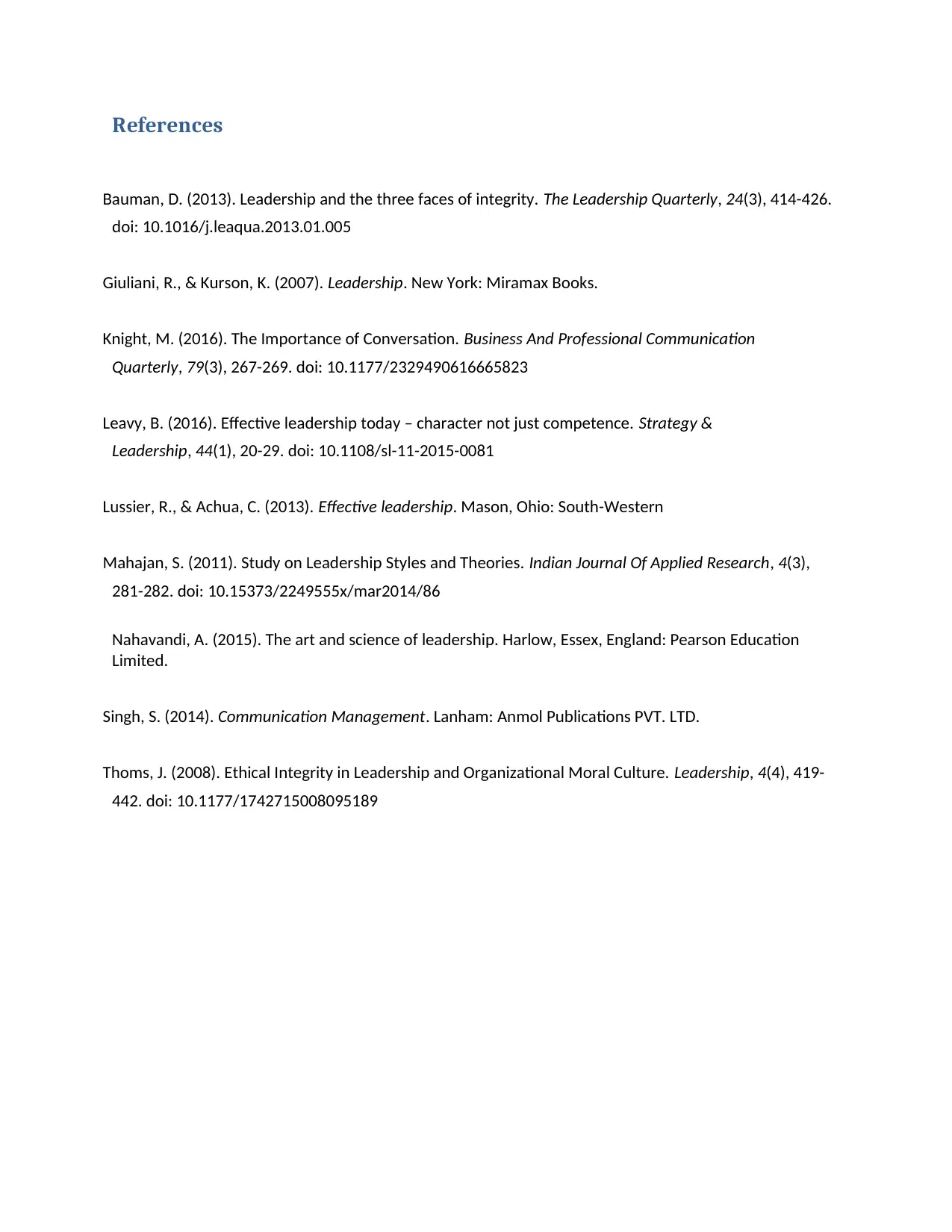
References
Bauman, D. (2013). Leadership and the three faces of integrity. The Leadership Quarterly, 24(3), 414-426.
doi: 10.1016/j.leaqua.2013.01.005
Giuliani, R., & Kurson, K. (2007). Leadership. New York: Miramax Books.
Knight, M. (2016). The Importance of Conversation. Business And Professional Communication
Quarterly, 79(3), 267-269. doi: 10.1177/2329490616665823
Leavy, B. (2016). Effective leadership today – character not just competence. Strategy &
Leadership, 44(1), 20-29. doi: 10.1108/sl-11-2015-0081
Lussier, R., & Achua, C. (2013). Effective leadership. Mason, Ohio: South-Western
Mahajan, S. (2011). Study on Leadership Styles and Theories. Indian Journal Of Applied Research, 4(3),
281-282. doi: 10.15373/2249555x/mar2014/86
Nahavandi, A. (2015). The art and science of leadership. Harlow, Essex, England: Pearson Education
Limited.
Singh, S. (2014). Communication Management. Lanham: Anmol Publications PVT. LTD.
Thoms, J. (2008). Ethical Integrity in Leadership and Organizational Moral Culture. Leadership, 4(4), 419-
442. doi: 10.1177/1742715008095189
Bauman, D. (2013). Leadership and the three faces of integrity. The Leadership Quarterly, 24(3), 414-426.
doi: 10.1016/j.leaqua.2013.01.005
Giuliani, R., & Kurson, K. (2007). Leadership. New York: Miramax Books.
Knight, M. (2016). The Importance of Conversation. Business And Professional Communication
Quarterly, 79(3), 267-269. doi: 10.1177/2329490616665823
Leavy, B. (2016). Effective leadership today – character not just competence. Strategy &
Leadership, 44(1), 20-29. doi: 10.1108/sl-11-2015-0081
Lussier, R., & Achua, C. (2013). Effective leadership. Mason, Ohio: South-Western
Mahajan, S. (2011). Study on Leadership Styles and Theories. Indian Journal Of Applied Research, 4(3),
281-282. doi: 10.15373/2249555x/mar2014/86
Nahavandi, A. (2015). The art and science of leadership. Harlow, Essex, England: Pearson Education
Limited.
Singh, S. (2014). Communication Management. Lanham: Anmol Publications PVT. LTD.
Thoms, J. (2008). Ethical Integrity in Leadership and Organizational Moral Culture. Leadership, 4(4), 419-
442. doi: 10.1177/1742715008095189
⊘ This is a preview!⊘
Do you want full access?
Subscribe today to unlock all pages.

Trusted by 1+ million students worldwide
1 out of 6
Related Documents
Your All-in-One AI-Powered Toolkit for Academic Success.
+13062052269
info@desklib.com
Available 24*7 on WhatsApp / Email
![[object Object]](/_next/static/media/star-bottom.7253800d.svg)
Unlock your academic potential
Copyright © 2020–2025 A2Z Services. All Rights Reserved. Developed and managed by ZUCOL.



